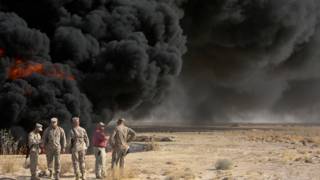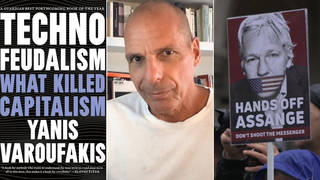
Related
Guests
- Malachi Muncymanager of the Under the Hood Café in Killeen since 2012. He served in the Texas Army National Guard from June 2003 until June 2009 and served two deployments to Iraq, in 2004-2005 and 2006-2007.
- Ryan Holleranserved as an infantryman in the Army from 2010 to 2013 and deployed to Iraq in 2011. He was stationed at Fort Hood for his entire time in the Army when he was not overseas. He is a member of Iraq Veterans Against the War and is helping to produce their report coming out on Memorial Day about soldiers at Fort Hood, that includes recommendations for policy changes there.
- Aaron Glantzcovers veterans and domestic military issues for The Center for Investigative Reporting. Glantz has spent more than 10 years covering the Iraq War and the treatment veterans receive when they come home. He is author of three books on the war, most recently The War Comes Home: Washington’s Battle Against America’s Veterans.
We begin today’s show at Fort Hood, Texas, where flags are flying at half-mast following Wednesday’s shooting that left four dead, including the gunman. Sixteen people were wounded in the attack. Authorities identified the shooter as 34-year-old Army Specialist Ivan Lopez, who was being evaluated for post-traumatic stress disorder. Lopez served in Iraq, but officials say he never saw combat. We speak with two Iraq War veterans: Ryan Holleran and Malachi Muncy, manager of the Under the Hood Café, a GI coffee shop near Fort Hood. Both are members of Iraq Veterans Against the War. “I had trouble getting help when I came back from Iraq, as well, when I was at Fort Hood. The access to healthcare is limited — it is available, but it’s not necessarily accessible,” Holleran explains. “The amount of stigma associated with seeking any kind of mental health, it makes it extremely challenging to try to take care of ourselves.” We also talk to Aaron Glantz, who covers veterans and domestic military issues for The Center for Investigative Reporting. His most recent book is “The War Comes Home: Washington’s Battle Against America’s Veterans.”
Transcript
AMY GOODMAN: We begin today’s show at Fort Hood, Texas, where flags are flying at half-mast following Wednesday’s shooting that left four dead, including the gunman. Sixteen people were wounded in the attack. Authorities identified the shooter as 34-year-old Army Specialist Ivan Lopez, who was being evaluated for post-traumatic stress disorder. Lopez served in Iraq, but officials say he never saw combat. This is base commander Lieutenant General Mark Milley.
We’ll go to that clip in a moment. But no motive was given for what was the second mass shooting in five years at the country’s largest military base. It was the third shooting at a military base in the United States in about six months, including the shooting spree in September that left 12 people dead at the Washington Navy Yard. Last year, Major Nidal Hasan sentenced to death for committing the worst attack on a U.S. base in history, killing 13 fellow soldiers and injuring scores of others at Fort Hood in 2009. Defense Secretary Chuck Hagel said the repeated soldier-on-soldier attacks on military installations suggest, quote, “something is not working.”
DEFENSE SECRETARY CHUCK HAGEL: As the Fort Hood investigation unfolds, we will continue to take a close look to identify any new lessons learned and implement those, as well. In the meantime, we will all stay focused on the victims and their families and the Fort Hood community, who, yet again, are experiencing a terrible tragedy and much grief.
AMY GOODMAN: Well, for more, we’re joined by three guests. From his home near Fort Hood, Texas, we’re joined by Malachi Muncy, manager of the Under the Hood Café in Killeen since 2012. He served in the Texas Army National Guard from 2003 'til 2009 and served two deployments to Iraq between 2004 and ’07. He's now a member of Iraq Veterans Against the War and Iraq Veterans for Peace. Last night he helped organize a vigil outside at Fort Hood.
And in San Francisco, we’re joined by Ryan Holleran, who served as an infantryman in the Army from 2010 to 2013 and deployed to Iraq in 2011. He was stationed at Fort Hood for his entire time in the Army when he was not overseas. He’s a member of Iraq Vets Against the War and is helping produce their report coming out on Memorial Day about soldiers at Fort Hood, that includes recommendations for policy change.
And Aaron Glantz joins us. He covers veterans and domestic military issues for The Center for Investigative Reporting. He’s spent more than 10 years covering the Iraq War and the treatment veterans receive when they come home. He’s author of three books on the war, most recently, The War Comes Home: Washington’s Battle Against America’s Veterans.
We welcome you all to Democracy Now! I want to first go—excuse me—let’s first go to Killeen to the café right outside Fort Hood to talk about right now the atmosphere at Fort Hood. Malachi Muncy?
MALACHI MUNCY: Yes.
AMY GOODMAN: Tell us—you’re at the Under the Hood Café, which is a café that’s right outside of Fort Hood. Talk about what’s happened over the last two days.
MALACHI MUNCY: I think—I think it’s been—it’s been very strange and—and, initially, just really reopening traumatic wounds, both of our military experiences and the shooting in 2009. It’s been tragic and traumatizing.
AMY GOODMAN: Ryan Holleran, you were at Fort Hood for quite a long time. Talk about your experience there and your response to this latest shooting.
RYAN HOLLERAN: Sure. I mean, first I’d like to say that my—extend my heart and my sympathies out to the victims and their families. I mean, foremost, this is a tragedy, and, you know, it’s a terrible thing to see have happened, also that it’s the second time at the same base. But, you know, the reaction that I’ve gotten from a lot of my buddies who are still at Fort Hood and reaction from veterans in social media seems to be one that’s not terribly surprised, I guess.
AMY GOODMAN: Can you talk about—in your time at Fort Hood, Ryan, were their discussions about these shootings and possible shootings? Of course, in 2009, you had another very serious attack.
RYAN HOLLERAN: Sure. I mean, there was definitely an awareness. You know, security was heightened for a period of time, before it was relaxed again. You know, everybody who was stationed there was very well aware of the previous shooting. You know, you couldn’t do your morning physical training without running by the building and the wall of flowers, so it was a regular reminder of what had happened in 2009. You know, in addition to that, the active-duty suicide rates are also very high, so I think it’s nothing these soldiers have never been exposed to before. I think suicide has, unfortunately, become all too commonplace at—I think, in the DOD and at Fort Hood.
AMY GOODMAN: Aaron Glantz, first of all, congratulations on winning a Peabody for your critical work about what happens to soldiers when they come back. And here on Fort Hood, we’re talking about an active-duty soldier. You look at veterans. But if you could talk about this issue of suicide, of soldiers coming home?
AARON GLANTZ: Well, we have had over 10 years of war. You know, this began 9/11/2001; here we are in 2014. And so many people have served so many deployments. I mean, 2.6 million people have gone to serve in these wars, many multiple times, over such an extended period. We have hundreds of thousands of people coming home with post-traumatic stress disorder, major depression. We have hundreds of thousands of people coming home with traumatic brain injury, physical brain damage from roadside bombs and mortars. We have huge gaps in care both on the active-duty side and the VA side.
And now we’re just kind of beginning to try to piece together how all of this kind of 10,000-feet picture might or might not fit into this tragedy that we’ve seen at Fort Hood. We know that the shooter was an Iraq War veteran who served at the very end of our engagement in Iraq, who served a very short tour, who may have sustained a traumatic brain injury, who was seeking treatment for post-traumatic stress disorder. And hopefully in the coming days and weeks, we’ll get some clarity.
AMY GOODMAN: Let’s go now to Fort Hood base commander Lieutenant General Mark Milley talking about Army Specialist Ivan Lopez.
LT. GEN. MARK MILLEY: We have very strong evidence that he had a medical history that indicates a unstable psychiatric or psychological condition. We’re going through all the records to ensure that that is in fact correct, but we believe that to be the fundamental underlying causal factors.
AMY GOODMAN: That is Lieutenant General Mark Milley. I want to go to Malachi Muncy right near Fort Hood, right at the café outside that serves soldiers and vets, Under the Hood Café. Talk about how the military is talking about these shootings.
MALACHI MUNCY: I think some of the language that’s being used is sort of telling to where they want responsibility to fall. When talking about some of these mental health issues, I’ve noticed that they’ve used a lot of language that refers to anxiety and sleeping problems and such, and some of these are symptoms of PTSD, but they’re not using—they’re trying to stay away from—it seems, trying to stay away from actually using the term PTSD or anything else that might be related to his service, it seems. It seems almost as if they’re trying to talk about some of these issues as if they may have been pre-existing conditions to his service or something like that. And I think that sort of illustrates what a lot of folks are experiencing in having their symptoms sort of placed on them in some pre-existing sort of way or in some unrelated-to-their-service way, rather than allowing these issues to be connected to their service. And it affects their benefits and such like that. And, yeah.
AMY GOODMAN: U.S. Army officials say that Ivan Lopez, who was 34 years old, joined the Puerto Rico National Guard in 1999, when he would have been about 18 or—or, 19 or 20. Officials said he served in Iraq in 2011 for four months, didn’t see combat but was a truck driver. They said he came back and said he suffered post-traumatic—that he suffered from a brain injury, but they didn’t see any records from Iraq that indicated he had been injured, though they do admit that he was—had seen a psychiatrist for post-traumatic stress disorder. Aaron Glantz, can you talk about the treatment of soldiers when they come home, around issues of PTSD, around issues of brain injury, and when they get treated?
AARON GLANTZ: Well, I think that the military, especially now that the combat in Iraq is over and the combat in Afghanistan involves a lot fewer soldiers than it used to, has been a little bit more proactive certainly than in the earlier part of the war in treating these conditions. But still, a lot of people fall through the cracks.
I find it personally preposterous that somebody could have been in Iraq and not seen combat. Maybe not from the conventional definition of combat that the Army uses, but if you’re driving a truck up and down the highways in Iraq during the final months of the war, when bases are being rocketed, when everybody knows that America is leaving, it’s certainly less physically dangerous than when I was in Iraq in Fallujah and Najaf in 2004 and 2005, but still, you know, not a walk in the park by any means.
And the fact that he had a brain injury that he spoke about that was not documented in his military medical record is also not surprising, because this is a big problem that a lot of soldiers have, that their injuries are not being written down, and then they go later to the VA to get their benefits, and they’re told that there’s no record of their injuries. So there’s a lot of unanswered questions at this early date and a lot of things in this case that are both similar and different than the broader trends that we see.
AMY GOODMAN: Ryan Holleran, you’re nodding your head. If you could talk about this description of Ivan Lopez not having seen combat in Iraq and what it means to come home. Talk about your own experience.
RYAN HOLLERAN: Sure. You know, it seems to be a common narrative of—like right now, as people are talking about the shooting, it’s trying to devalue this person’s experience in a war country. I mean, I was in Iraq in 2011, as well, and I can relate, like although it was not like a Fallujah or Sadr City situation, we were receiving, you know, rockets on a regular basis, which may not be technically classified as a combat situation. So, I guess I could see trauma as a spectrum, and I could see a person’s reaction to that trauma as a spectrum, as well, so—this, of course, being the most extreme example. You know, I had trouble getting help when I came back from Iraq, as well, when I was at Fort Hood. The access to healthcare is limited. And it’s not—I mean, it’s available, but it’s not necessarily accessible. I mean, living in a combat arms unit, the amount of stigma associated with seeking any kind of mental health, it makes it incredibly challenging to try to take care of ourselves before we get to that point.
AMY GOODMAN: So you came back. You suffered from depression. How did the doctors respond?
RYAN HOLLERAN: You know, I got a slew of diagnoses: depression, anxiety, bipolar personality disorder. I mean, basically everything but PTSD, for the longest time. And only now that I’m in with the VA system are we starting to, you know, kind of get through that a little bit. But, you know, I’m not unique in that. I think that a lot of DOD physicians really hesitate to give the PTSD diagnosis. And I’m not going to speculate as to why that is, but I’ll definitely say that it affects that servicemember’s ability to get benefits on the other side.
AMY GOODMAN: Malachi Muncy, right over there just outside Fort Hood, you were nodding your head, too, around the military’s description of Ivan Lopez not having seen combat in Iraq.
MALACHI MUNCY: Yeah. I was a truck driver, as well, and so, yeah, I find it hard to believe that a truck driver wasn’t under the sort of the stresses that would possibly cause some of these issues. And I was really just nodding my head along with what Aaron was saying about the difficulty receiving a PTSD diagnosis and how it seems they want to—for whatever reason, it just—it appears the trend is that folks are being I diagnosed with everything but PTSD before they get to a PTSD diagnosis.
AMY GOODMAN: We’re going to break and come back to this discussion. Malachi Muncy is with us. He’s just outside Fort Hood at a café called Under the Hood. Ryan Holleran is with Iraq Veterans Against the War, served in Iraq. Aaron Glantz is with us, who has been looking at veterans at home and the treatment they receive for years. His latest book, The War Comes Home: Washington’s Battle Against America’s Veterans. Stay with us.












Media Options